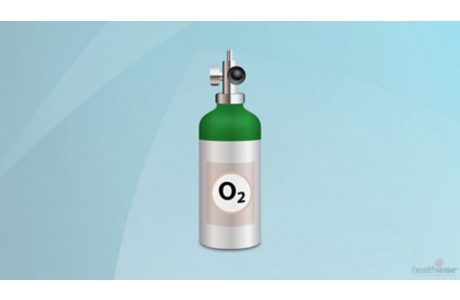Top of the pageActionset
Oxygen Therapy: Using Oxygen at Home
Overview
Oxygen therapy helps you get more oxygen into your lungs and bloodstream. You may use it if you have a disease that makes it hard to breathe, such as COPD, pulmonary fibrosis (scarring of the lungs), or heart failure. Oxygen therapy can make it easier for you to breathe and can reduce your heart's workload.
Some people need extra oxygen all the time. Others need it from time to time throughout the day or overnight. A doctor will prescribe how much oxygen you need and how often to use it.
To breathe the oxygen, most people use a nasal cannula (say "KAN-yuh-luh"). This is a thin tube with two prongs that fit just inside your nose. People who need a lot of oxygen may need to use a mask that fits over the nose and mouth.
How to use oxygen therapy
If you need oxygen at home, it is important to learn how to use and take care of your equipment.
- Do not change the setting on your oxygen without talking to your doctor first.
Turning the flow rate up or down could put you in danger.
- Keep track of how much oxygen is in the tank.
Order more in advance so you don't run out.
- Do not drink alcohol or take drugs that relax you while using oxygen.
Alcohol, sleeping pills, or sedatives and other drugs can make you breathe too slowly.
- Be aware of tripping hazards.
Make sure you are careful when you are moving around. You or someone else could trip and fall over the cords, oxygen tubing, or canisters.
- Take care of your nasal cannula and skin.
- Use water-based lubricants on your lips or nostrils. Do not use an oil-based product like petroleum jelly. They may cause skin burns.
- To keep your skin from getting sore, tuck some gauze under the tubing. Use a water-based lotion on rubbed areas.
- Wash your cannula with a liquid soap and warm water daily. Replace it every 2 to 4 weeks.
- If you have a cold, change the nasal prongs when your cold symptoms are done.
- Use oxygen safely.
Oxygen is a fire hazard. It will make a flame burn hotter and faster.
- Never smoke or vape or let anyone else smoke or vape while you are using oxygen.
- Keep oxygen at least 6 ft (2 m) away from flames, sparks, or heat sources.
- Do not use flammable products while you are using oxygen.
- Keep a fire extinguisher at home within easy reach.
- Keep oxygen tanks upright.
- Call your doctor.
Let your doctor know if you:
- Feel short of breath.
- Feel restless or confused.
- Feel very tired.
- Feel like you are not getting enough oxygen.
Traveling while on oxygen therapy
Traveling while you are on oxygen therapy usually is possible if you plan ahead.
- See your doctor several weeks to months before your travel date. Ask your doctor to:
- Figure out how much oxygen you'll need.
- Complete the medical forms you'll need. This may include copies of your oxygen prescription.
- Recommend a doctor in the places where you will travel, in case you need medical care during your trip.
- Before the trip, tell the travel company (airline, cruise ship, train, or bus) that you use oxygen. They may have rules that you'll need to follow.
Depending on what kind of oxygen delivery you use, you may need to:
- Learn how to use a portable oxygen tank. It's important to know how long it will last and to bring refills if needed.
- Get a portable oxygen concentrator. Some types of oxygen concentrators can be taken on airplanes, cruise ships, buses, and trains.
Watch
Credits
Current as of: August 6, 2023
Author: Healthwise Staff
Clinical Review Board
All Healthwise education is reviewed by a team that includes physicians, nurses, advanced practitioners, registered dieticians, and other healthcare professionals.
Current as of: August 6, 2023
Author: Healthwise Staff
Clinical Review Board
All Healthwise education is reviewed by a team that includes physicians, nurses, advanced practitioners, registered dieticians, and other healthcare professionals.
This information does not replace the advice of a doctor. Healthwise, Incorporated, disclaims any warranty or liability for your use of this information. Your use of this information means that you agree to the Terms of Use. Learn how we develop our content.



